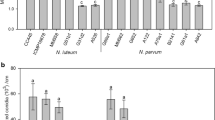Abstract
This study investigated some factors that affect Neofusicoccum luteum infection and disease progression in grapevines, on which it causes cankers and die-back. Inoculation of green shoots with each of the conidial suspensions (20 μL of 102–106 conidia/mL) caused 100 % infection, but significant differences in lesion lengths among concentrations (P < 0.001). Lesion lengths increased with conidial concentrations to a maximum of 41.7 mm, in tissue inoculated with 104/conidial. Lesions then decreased for 105 and 106 conidial/mL (28.6 and 27.8 mm, respectively). The different wetness durations (0–24 h) tested after inoculating trunks of 1-year old vines with conidia did not affect pathogen incidence or lesion lengths, however continued incubation at 95 % RH caused greater pathogen progression (maximum isolation distances from point of inoculation; P < 0.001; 100.6 mm) than at ambient 78 % RH (77.0 mm) within 3 months after inoculation. Inoculation of trunks, canes and green shoots caused different rates of pathogen colonisation (P < 0.001); by 5 months after N. luteum inoculation mean maximum distances were 39.1, 31.6 and 23.2 mm, respectively. Wound age at the time of inoculation significantly affected (P < 0.001) infection incidence by N. luteum, which decreased as wounds aged. Conidial inoculum caused 100-0 % incidence over 0–14 days and mycelial inoculum caused 100-40 % infection over 0–30 days. Soil moistures affected lesion development, with 15 and 100 % soil moisture causing greatest dieback and bud death during winter. This study has shown how some features of the natural infection environment can affect infection by Botryosphaeria spp. inoculum and symptom development, which could underpin improvements in vineyard management.


Similar content being viewed by others
References
Amponsah NT, Jones EE, Ridgway HJ, Jaspers MV (2008) Production of Botryosphaeria species conidia using grapevine green shoots. N Z Plant Protect 61:301–305
Amponsah NT, Jones EE, Ridgway HJ, Jaspers MV (2009) Rainwater dispersal of Botryosphaeria conidia from infected grapevines. N Z Plant Protect 62:228–233
Amponsah NT, Jones EE, Ridgway HJ, Jaspers MV (2010) Effects of solar radiation and relative humidity on germination of Botryosphaeriaceae species conidia. N Z Plant Protect 63:28–32
Amponsah NT, Jones EE, Ridgway HJ, Jaspers MV (2011) Identification, potential inoculum sources and pathogenicity of botryosphaeriaceous species associated with grapevine dieback disease in New Zealand. Eur Plant Pathol 131:467–482
Amponsah NT, Jones EE, Ridgway HJ (2012) Jaspers MV (2012) susceptibility of grapevine tissues to Neofusicoccum luteum conidial infection. Plant Pathol 61(4):719–729
Arauz LF, Sutton TB (1989) Influence of temperature and moisture on germination of ascospores and conidia of Botryosphaeria obtusa. Phytopathology 79:667–674
Bagga DK, Smalley EB (1969) Factors affecting canker development on Populus tremuloides artificially inoculated with Hypoxylon pruinatum. Can J Bot 47(6):907–914
Balci Y, Balci S, MacDonald WL, Gottschalk KW (2008) Relative susceptibility of oaks to seven species of Phytophthora isolated from oak forest soils. For Pathol 38:394–409
Baskarathevan J, Jaspers MV, Jones EE, Ridgway HJ (2012) Incidence and distribution of botryosphaeriaceous species in New Zealand vineyards. Eur J Plant Pathol 132:549–560
Gubler WD, Eskalen A, RooneySN FAJ, Khan A (2002) Susceptibility of grapevine pruning wounds to infection by Phaeomoniella chlamydospora and Phaeoacremonium spp. Phytopathology 92:S32
Heiny DK, Templeton GE (1991) Effects of spore concentration, temperature, and dew period on disease of field bindweed caused by Phoma proboscis. Phytopathology 81(8):905–909
Larignon P, Dubos B (2000) Preliminary studies on the biology of Phaeoacremonium. Phytopathol Mediterr 39:184–189
Larignon P, Dubos B (2001) The villainy of black dead arm. Wine Vine 82:86–89
Luque J, Parladé J, Pera J (2002) Seasonal changes in susceptibility of Quercus suber to Botryosphaeria stevensii and Phytophthora cinnamomi. Plant Pathol 51:338–345
Ma Z, Morgan DP, Michailides TJ (2001) Effects of water stress on Botryosphaeria blight of pistachio caused by Botryosphaeria dothidea. Plant Dis 85:745–749
MollerW J, Kasimatis AN (1980) Protection of grapevine pruning wound from eutypa dieback. Plant Dis 64:278–280
Mostert L, Halleen F, Fourie PH, Crous PW (2005) A review of Phaeoacremonium species involved in Petri disease and esca of grapevines. Phytopathol Mediterr 45:12–29
Munkvold GP, Marois JJ (1995) Factors associated with variation in susceptibility of grapevine pruning wounds to infection by Eutypa lata. Phytopathology 85:249–256
Nao M (2008) Effects of inoculum density, leaf wetness duration and nitrate concentration on the occurrence of lettuce leaf spot. J Gen Plant Pathol 74(3):208–212
Neal M, Dryden G (2003) How much water does a grapevine use. How much water does a grapevine need: A practical perspective.Proceedings of the Romeo Bragato, 9th annual conference New Zealand
Parker KC, Sutton TB (1993) Susceptibility of apple fruit to Botryosphaeria dothidea and isolate variation. Plant Dis 77:385–389
Pusey PL (1989) Influence of water stress on susceptibility of nonwounded peach bark to Botryosphaeria dothidea. Plant Dis 73(12):1000–1003
Pusey PL, Bertrand PF (1993) Seasonal infection of nonwounded peach bark by Botryosphaeria dothidea. Phytopathology 83(8):825–829
Serra S, Mannoni MA, Ligios V (2008) Studies on the susceptibility of pruning wounds to infection by fungi involved in grapevine wood diseases in Italy. Phytopathol Mediterr 47:234–46
Smith H, Kemp GHJ, Wingfield MJ (1994) Canker and die‐back of Eucalyptus in South Africa caused by Botryosphaeria dothidea. Plant Pathol 43(6):1031–1034
Sosnowski MR, Lardner R, Wicks TJ, Scott ES (2007) The influence of grapevine cultivar and isolate of Eutypa lata on wood and foliar symptoms. Plant Dis 91:924–931
Stanosz GR, Blodgett JT, Smithand DR, Kruger EL (2001) Water stress and Sphaeropsis sapinea as a latent pathogen of red pine seedlings. New Phytol 149:531–538
Stoll M, Schultz HR, Berkelmann-Loehnertz B (2008) Thermal sensitivity of grapevine leaves affected by Plasmopara viticola and water stress. Vitis 47(2):133–134
Úrbez-Torres JR (2011) The status of Botryosphaeriaceae species infecting grapevines. Phytopathol Mediterr 50:S5–S45
Úrbez-Torres JR, Gubler WD (2011) Susceptibility of grapevine pruning wounds to infection by Lasioplodia theobromae and Neofusicoccum parvum. Plant Pathol 60:261–270
Úrbez-Torres JR, Battany M, Bettiga LJ, Gispert C, McGourty G, Roncoroni J, Smith RJ, Verdegaal P, Gubler WD (2010) Botryosphaeriaceae species spore-trapping studies in California Vineyards. Plant Dis 94(6):717–724
van Niekerk JM, Crous PW, Groenewald JZ, Fourie PH, Halleen F (2004) DNA phylogeny, morphology and pathogenicity of Botryosphaeria species on grapevines. Mycologia 96(4):781–798
van Niekerk JM, Fourie PH, Halleen F, Crous PW (2006) Botryosphaeria spp. as grapevine trunk disease pathogen. Phytopathol Mediterr 45:S43–S54
van Niekerk J, Strever A, Du Toit G, Halleen F, Fourie P (2011) Influence of water stress on Botryosphaeriaceae disease expression in grapevines. Phytopathol Mediterr 50(4):151–165
Acknowledgments
We are grateful to New Zealand Winegrowers Inc. and Lincoln University for funding this research and Peter Alspach, Biometrician at Plant & Food Research Institute for statistical advice.
Author information
Authors and Affiliations
Corresponding author
Rights and permissions
About this article
Cite this article
Amponsah, N.T., Jones, E.E., Ridgway, H.J. et al. Factors affecting Neofusicoccum luteum infection and disease progression in grapevines. Australasian Plant Pathol. 43, 547–556 (2014). https://doi.org/10.1007/s13313-014-0294-7
Received:
Accepted:
Published:
Issue Date:
DOI: https://doi.org/10.1007/s13313-014-0294-7




